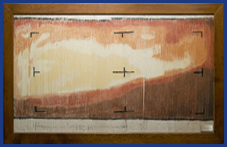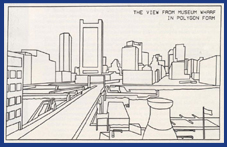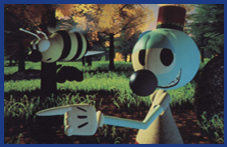 |
 |
 |
 |
 |
 |
 |
 |
A 4,000-square-foot gallery devoted to digital image processing and computer graphics. The exhibits addressed the history of the field, the basic principles of digital image processing and image synthesis, and applications using historical artifacts, explanatory text and images, interactive exhibits, and a computer animation theater. Many of the exhibits were developed with the help of university and corporate research labs. The exhibition was developed under the direction of Oliver Strimpel with Geoff Dutton. Digital Image Processing: The subject was introduced by a wall-sized mosaic of false-color Landsat images of Southern New England and New York. Possibly the first-ever digital image was on display from from Jet Propulsion Labs, consisting of hand-assembled colored strips of line-printer output from the Mariner 4 Mars probe (1965). An interactive exhibit enabled a visitor to play with the spatial and color resolution of imagery of his/her face. Computer Graphics: Displayed artifacts included early computer graphic input and output devices, such as the Rand Tablet and the MIT “Kludge” crystal globe. Videos showed classic graphics projects such as Ivan Sutherland’s Sketchpad and General Electric’s DAC-1, one of the first used of computer graphics in industrial design. “A Visualizer's Bestiary,” presented a tableau of real-world objects that have vexed programmers' attempts to render them realistically. In “A Window Full of Polygons,” a large pen-plotter rendered the silhouettes of the spectacular view of downtown Boston. Other interactive exhibits included a Koch snowflake fractal generator and the first computer game SPACEWAR! running on a PDP-1 and (more reliably) on a PC. Realistic Image Synthesis: Since the early 1970s, developers of synthetic lighting and shading algorithms for three-dimensional models have used a model of Martin Newell’s classic teapot. In the summer of 1984 at the ACM SIGGRAPH conference, Martin Newell donated his original teapot to Oliver Strimpel, wryly noting the symbolism of one Englishman giving another Englishman a teapot to be memorialized a stone's throw from the site of the Boston Tea Party revolt of 1773. The exhibit displayed Allan Newell's original ceramic teapot alongside an Adage frame buffer rendering a Bézier model of it, both responding interactively to changes in lighting controlled by museum visitors. Computer Animation: An animation theater performed a program of pioneering computer-animated shorts, including several from Pixar, such as The Adventures of Andre and Wally B and Luxo Jr. |
Opening: November 14, 1984 Square Footage: 4,000 sq.ft. Cost: Sponsors: Donors: Contributors: Funding: Grants: Development: Oliver Strimpel, Geoffrey Dutton, Andrew Kristoffy Design: Construction: Exhibit Advisors: Computer and the Image TCM Winter Report 1984-1985 Computer Animation TCM Summer Report 1985 Computer and the Image Enhancement TCM News Sept-Oct 1989 Hologram Animation American Graph Fleeting Hologram Animation A Visualizer's Beastiary First computer game SPACEWAR! Pixar computer-animated shorts Animated short - Hunger (1975) Animated short - Carla's Island (1980) Animated short - Vol Libre (1980) Animated short - Snoot and Muttly (1984) Animated short - The Adventures of Andre and Wally B. (1984) |
Upgraded: February 2015